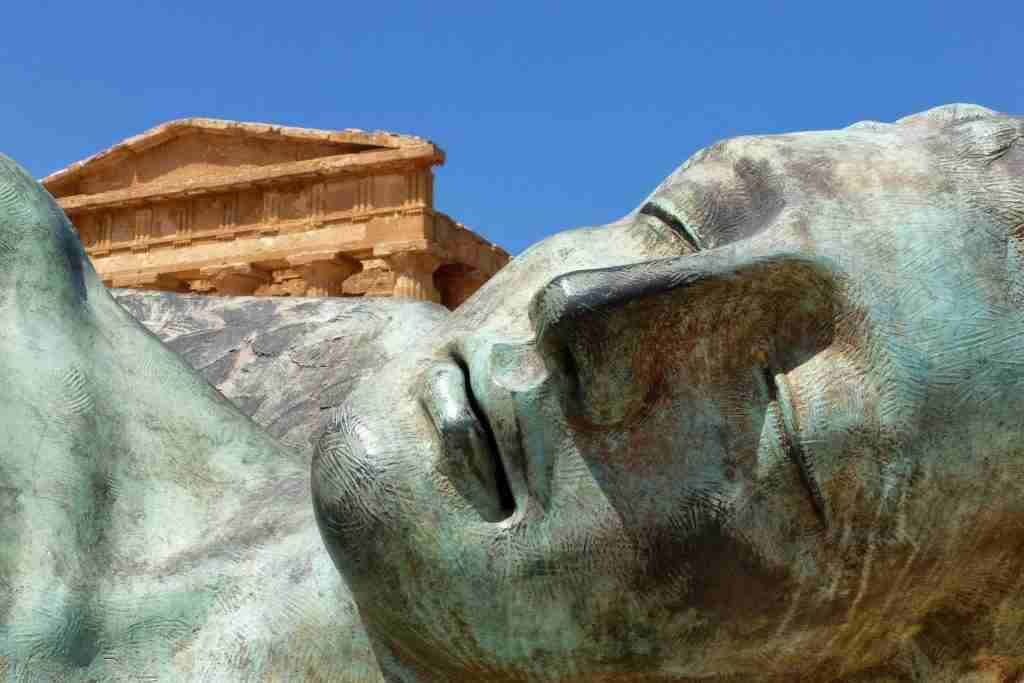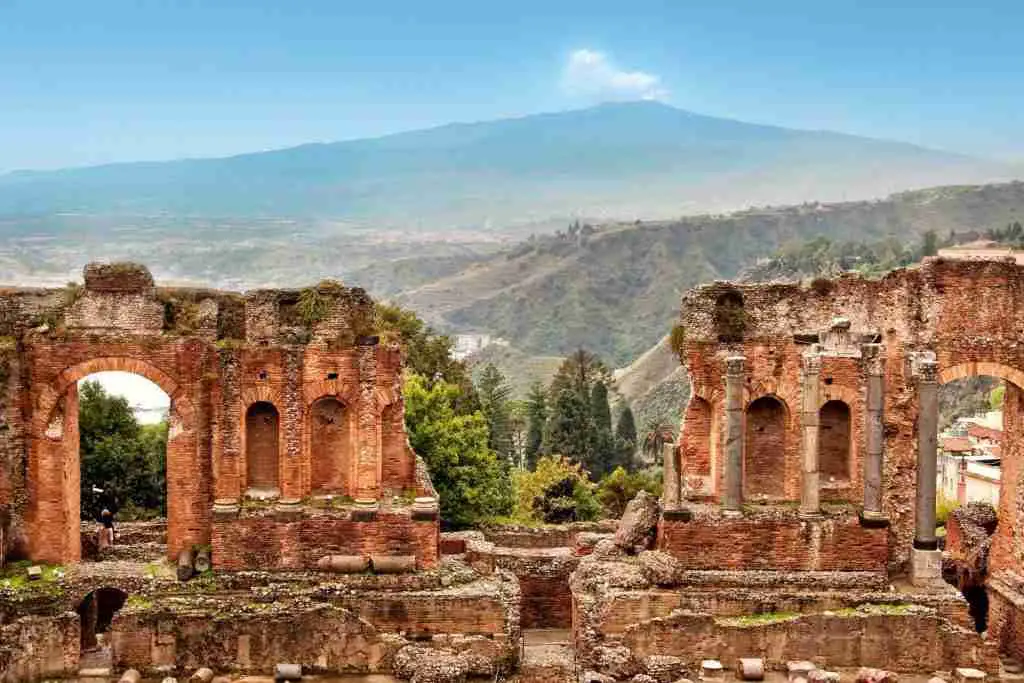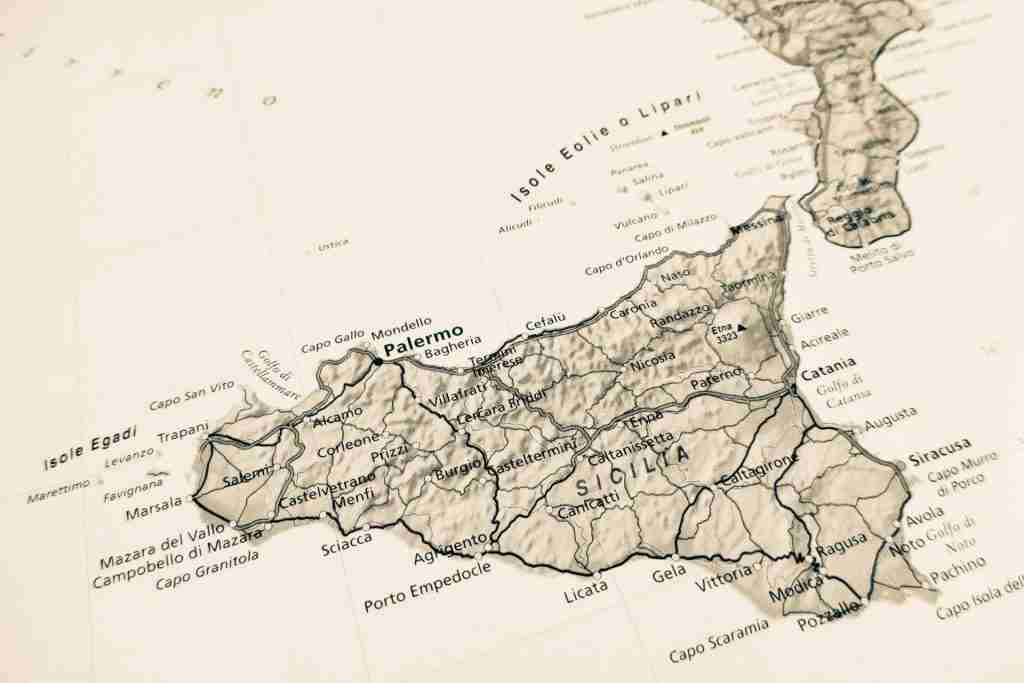Sicily, the largest region of modern Italy, has a multicultural history spanning over 3,000 years. It has been controlled by various empires such as Greek, Roman, Byzantine, Arab, Norman, Spanish and Bourbon; however, it has also experienced periods of independence. Even though it is now part of Italy, Sicily has its own distinct culture.
“Going to Sicily is better than going to the moon.”
Gabriel García Márquez
Its location in the Mediterranean made it a crucial strategic location for Mediterranean trade routes. In this article we’ll introduce the multicultural history of Sicily: from ancient times to modern era.
We will embark on a journey through Sicily’s diverse history, from the first inhabitants and Phoenician settlements to Greek colonization, Roman rule, and the island’s struggles for independence. We will also explore the impact of the various empires on Sicilian culture, the unification of Italy, modern Sicily, and its rich and vibrant culture. Join us on this exciting journey through Sicily’s history!

The multicultural history of Sicily: Prehistory
Sicily is a crucial strategic location due to its central location and natural resources, and is considered part of Magna Graecia or Greater Greece. The island’s attractiveness to various peoples is attributed to its fertility. Sicily is now part of the Republic of Italy, but it has a unique culture.
The first inhabitants of Sicily arrived around 20,000 B.C.E. from Central and Western Europe. Ancient Greek writers knew the indigenous people as the Elymians, the Sicani, and the Siculi or Sicels, after which the island is named. Settlements became increasingly complex from around 1300 B.C.E. Phoenicians established settlements in western Sicily from the eleventh century B.C.E. and already had colonies on nearby parts of North Africa. Major Phoenician settlements included Palermo and Solunto, just off the shores of southern Italy.
Greek Colonization
Sicily, with its fertile landscapes and abundance of natural produce, had always been a coveted prize for traders and conquerors alike. After the Phoenicians, the Greeks arrived on the island around 750 BC, and they were quick to colonize it, as well as much of southern Italy. They dubbed the region Magna Graecia or Greater Greece and established several colonies in the area.
The Greeks were attracted to Sicily for its agriculture potential and strategic location for trade routes. They quickly started establishing themselves on the island, building cities such as Naxos, Syracuse, Selinus and Akragas. But Sicily’s strategic value made it a lucrative target for the Carthaginians, who battled fiercely with the Greeks for control of the island.
For more than a century, the Greco-Punic wars raged on, causing civil unrest and leaving many of the cities in ruins. Despite the extensive battles, Ancient Greek remnants are still visible in modern Sicily, and are a key attraction for tourists today.
But despite the destruction caused by the wars, it was a turning point in the history of Sicily. The Battle of Himera in 480 BC saw the Carthaginians decimated, and the Greeks took control of the island.
Even though the Greeks held control of Sicily, they continued to be wary of the Carthaginians, who years later regained their power and under whom the Romans advanced their influence into Sicily.
The multicultural history: Roman Rule
Roman Rule saw a rise in power and influence of the Carthaginians, followed by the annexation and governance of Sicily by the Romans. During the struggle for control between the two powers, the island became a battleground, with the Greco-Punic wars lasting for over a century. The battle of Himera in 480 BC was a critical moment in Sicilian history, leading to the decimation of the Carthaginians and the emergence of Sicily as a Roman province.
Carthaginian advancements included extensive agriculture and mining, leading to a significant boost in Sicilian productivity and economic growth. This economic prosperity was accompanied by Roman annexation and governance, which centralized control under the Roman Empire and established as a prominent and integral part of the empire. Sicily served as a grain basket for Rome, providing over a third of the empire’s wheat supply, and also as a key military stronghold.
Under Roman rule, it saw significant developments in architecture, culture, and arts.
The most notable examples of Roman architecture: include the Valley of the Temples in Agrigento, an excellent example of Corinthian architecture, and the amphitheatre ruins in Syracuse.
Overall, Roman rule played a significant role in shaping Sicily’s diverse and multicultural history, laying the foundation for centuries of complex cultural and political dynamics.

Byzantine, Arab, and Norman Rule
The fall of the Western Roman Empire in 476 CE didn’t change much for Sicily. The island gradually shifted to Byzantine rule after the successful invasion of North Africa by the Byzantine Empire in the 6th century. However, the Byzantine empire reclamation of Sicily was quite disastrous, causing significant destruction and damage to entire cities. Palermo was reduced to almost nothing. It was only during the Arab Invasion of Sicily that the island gained any significant attention.
The Islamic Expansion in the seventh century brought Sicily, along with many other parts of the Mediterranean, under Muslim rule. Palermo became one of the most important Islamic cultural hubs and flourished under Arab rule. Arabic language and culture influenced the Sicilian dialect and also made Arabic architecture a natural part of the island’s heritage. The Arabs constructed many iconic structures such as the Palace of the Normans and the Zisa Castle, which are still preserved in Sicily.
The Normans arrived in the latter half of the 11th century and dominated the island culturally, resulting in surprisingly unique interchanges between the Islamic, Greek, and Latin elements. The renaissance of the Greek culture by the Norman Empire began when they granted town status to Greek cities such as Messina and Siracusa. With Norman rule, the island discovered new prosperity and cultural refinement. The Normans made huge contributions to the Sicilian local language, culture, architecture and art.
Sicily’s multicultural heritage draws much of its vibrancy from the Byzantine, Arab, and Norman rulers who helped establish an island that took center stage in the Mediterranean’s cultural life. These rulers, by integrating Sicily’s distinctiveness with the elements they brought from their respective domains, created a diverse society that proudly holds on to its accomplishments in art, architecture, music, and literature till date.
The multicultural history: Spanish and Bourbon Rule
After the Sicilian Vespers, the Spanish took control of the island and continued their reign for over 200 years. They brought with them the Inquisition and the horrors that came with it. In a display of exploitation, the Spanish made sure to squeeze every penny they could out of Sicily, from taxes on salt to the sale of noble titles. Despite their power, the Sicilian people continued to resist. The island became a hotbed of secret societies, such as the Carbonari, that aimed to overthrow their oppressors.
In the early eighteenth century, Bourbon rule replaced Spanish control. Rather than being an improvement, Bourbon rule was marked by even greater exploitation and neglect. The Bourbon dynasty was too preoccupied with their own affairs to care about Sicily and they left the island to rot. This neglect only served to strengthen the Sicilian people’s resolve to resist.
In 1848, rebelled against Bourbon rule, but their attempt at independence was short-lived. The rebellion was crushed, but it didn’t mean the end of Sicily’s fight for self-determination. In 1860, Garibaldi and his troops invaded Sicily as a part of his conquest of the Italian peninsula. The Sicilians were divided in their response to Garibaldi’s arrival. While some welcomed him as a liberator, others were suspicious of his intention to join to the Italian state.
The unification of Italy saw a centralized government established in Rome, but many Sicilians felt left out and resentful. They saw themselves as a separate people with their own distinct culture and identity. The new rulers of Italy did nothing to alleviate their concerns and instead placed more emphasis on Italy’s history and traditions.
In conclusion, Sicily’s history has been a long and tumultuous one, marked by domination, exploitation, and resistance. Despite the attempts of foreign powers to subjugate it, the island has managed to maintain its unique culture and identity. Today, Sicily is a thriving region of Italy, with a vibrant economy and rich cultural heritage. However, its history serves as a reminder of the importance of standing up for oneself in the face of oppression and adversity.
The multicultural history: unification of Italy
Garibaldi’s invasion of Sicily in 1860 marked a turning point in the political landscape of the island. Sicilians welcomed Garibaldi’s forces as liberators from the oppressive rule of the Bourbon kingdom, which had dominated the island for centuries. Garibaldi managed to unite Sicily and Naples into one kingdom and helped to usher in the era of Italian unification. However, the initial euphoria gradually faded as the centralized government in Rome and its policies towards Sicily were viewed as discriminatory and exploitative. Sicilians felt marginalized and neglected, leading to resentment towards the new Italian state.
Centralized Italian rule brought some benefits, such as the construction of new infrastructure and the establishment of new industries. However, the benefits were not evenly distributed, and Sicily continued to suffer from economic and social inequalities. These conditions eventually gave rise to the Sicilian Mafia and its organized crime, as a way for the locals to seek justice and protection in the absence of a responsive government.
Today, remains an autonomous region in the Republic of Italy, with its own distinct culture, language, and traditions. The island has made significant progress in recent decades, particularly in the areas of tourism and cultural preservation. Nevertheless, the legacy of foreign domination and exploitation is still evident in the economic and social challenges facing the island today.

Modern Sicily
Sicily has come a long way since its tumultuous past. Today, it is a thriving tourist destination, boasting picturesque landscapes, world-renowned cuisine, and one of the most distinctive cultures in Italy.
However, the island is still plagued by the legacy of the notorious Sicilian mafia. Organized crime has long been a part of Sicily’s history, and it continues to exert a significant influence on the island’s politics, economy, and social fabric.
Despite this, Sicily has managed to build a diverse and sustainable economy. Agriculture, fishing, and tourism are the mainstays of the island’s economy, and the region is home to a thriving community of small businesses and artisans.
The island’s rich cultural heritage is also a major draw for tourists. From ancient Greek temples to ornate Norman churches, Sicily is home to some of the most impressive historical sites in Italy. Traditional festivals, lively markets, and vibrant street life also offer visitors a glimpse into Sicily’s unique cultural identity.
Despite the challenges it has faced, Sicily continues to chart its own course. The island’s vibrant culture, stunning natural beauty, and complex history make it a fascinating place to explore – and a testament to the resilience and spirit of the Sicilian people.
The Bottom Line
In this content, we talked about the multicultural history of Sicily: from ancient times to modern era. Sicily’s diverse history is a fascinating tale of conquest, colonization, and integration. From the earliest inhabitants to the modern-day, it has been a coveted prize for empires and cultures seeking to control the Mediterranean trade routes. The Phoenicians, Greeks, Romans, Byzantines, Arabs, Normans, Spanish, and Bourbons have all left their mark on the island’s identity, shaping its customs, heritage, and traditions.
Although periods of independence have been fleeting, Sicilian culture remains distinctive, with a mix of influences that have created a unique blend of traditions, arts, and cuisine. The island’s rich history is evident in its ancient Greek ruins, Norman architecture, and Baroque churches, all of which attract millions of visitors each year.
Despite its turbulent past, Sicily has emerged as a modern society, with a thriving tourism industry, a diversified economy, and a vibrant culture. Still haunted by its past of organized crime and corruption, it has come a long way in reclaiming its identity and carving out its place in the world. Whether you’re exploring its ancient ruins, tasting its delicious cuisine, or soaking up its vibrant culture, Sicily is a testament to the resilience of the human spirit and the enduring legacy of centuries-old civilizations. Keep following us to find out more trivia, historical facts and our LCN App.

